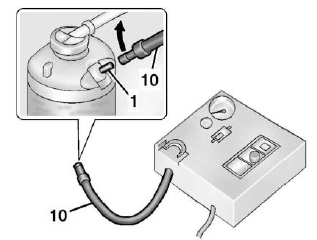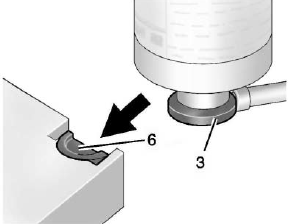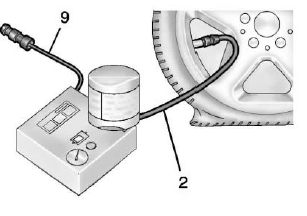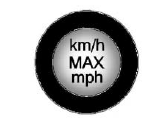Chevrolet Equinox Owners Manual: Using the Tire Sealant and Compressor Kit to Temporarily Seal and Inflate a Punctured Tire
When using the tire sealant and compressor kit during cold temperatures, warm the kit in a heated environment for five minutes.
This will help to inflate the tire faster.
If a tire goes flat, avoid further tire and wheel damage by driving slowly to a level place. Turn on the hazard warning flashers. See Hazard Warning Flashers.
See If a Tire Goes Flat for other important safety warnings.
Do not remove any objects that have penetrated the tire.
- Remove the tire sealant canister (4) and compressor from its storage location. See Storing the Tire Sealant and Compressor Kit.
- Remove the air only hose (10) and the power plug (9) from the bottom of the compressor.
- Place the compressor on the ground near the flat tire.

- Attach the air only hose (10) to the sealant canister inlet valve (1) by turning it clockwise until tight.

- Slide the base of the tire
sealant canister (3) into the slot
on the top of the compressor
(6) to hold it upright.
Make sure the tire valve stem is positioned close to the ground so the hose will reach it.
- Remove the valve stem cap from the flat tire by turning it counterclockwise.

- Attach the sealant/air hose (2) to the tire valve stem by turning it clockwise until tight.
- Plug the power plug (9) into the
accessory power outlet in the
vehicle. Unplug all items from
other accessory power outlets.
See Power Outlets.
If the vehicle has an accessory power outlet, do not use the cigarette lighter.
If the vehicle only has a cigarette lighter, use the cigarette lighter.
Do not pinch the power plug cord in the door or window.
- Start the vehicle. The vehicle must be running while using the air compressor.
- Press the on/off button (5) to
turn the tire sealant and
compressor kit on.
The compressor will inject sealant and air into the tire.
The pressure gauge (8) will initially show a high pressure while the compressor pushes the sealant into the tire. Once the sealant is completely dispersed into the tire, the pressure will quickly drop and start to rise again as the tire inflates with air only.
- Inflate the tire to the
recommended inflation
pressure using the pressure
gauge (8). The recommended
inflation pressure can be found
on the Tire and Loading
Information label. See Tire
Pressure.
The pressure gauge (8) may read higher than the actual tire pressure while the compressor is on. Turn the compressor off to get an accurate pressure reading. The compressor may be turned on/off until the correct pressure is reached.
| Caution If the recommended pressure cannot be reached after approximately 25 minutes, the vehicle should not be driven farther. The tire is too severely damaged and the tire sealant and compressor kit cannot inflate the tire. Remove the power plug from the accessory power outlet and unscrew the inflating hose from the tire valve. See Roadside Assistance Program. |
- Press the on/off button (5) to
turn the tire sealant and
compressor kit off.
The tire is not sealed and will continue to leak air until the vehicle is driven and the sealant is distributed in the tire.
Therefore, Steps 13-21 must be done immediately after Step 12.
Be careful while handling the tire sealant and compressor kit as it could be warm after usage.
- Unplug the power plug (9) from the accessory power outlet in the vehicle.
- Turn the sealant/air hose (2) counterclockwise to remove it from the tire valve stem.
- Replace the tire valve stem cap.
- Remove the tire sealant canister (4) from the slot on top of the compressor (6).
- Turn the air only hose (10) counterclockwise to remove it from the tire sealant canister inlet valve (1).
- Turn the sealant/air hose (2) clockwise onto the sealant canister inlet valve (1) to prevent sealant leakage.
- Return the air only hose (10) and power plug (9) back to their original storage location.

- If the flat tire was able to inflate
to the recommended inflation
pressure, remove the
maximum speed label from the
sealant canister and place it in
a highly visible location.
Do not exceed the speed on this label until the damaged tire is repaired or replaced.
- Return the equipment to its original storage location in the vehicle.
- Immediately drive the vehicle 8 km (5 mi) to distribute the sealant in the tire.
- Stop at a safe location and
check the tire pressure. Refer
to Steps 1-10 under "Using the
Tire Sealant and Compressor
Kit without Sealant to Inflate a
Tire (Not Punctured)."
If the tire pressure has fallen
more than 68 kPa (10 psi)
below the recommended
inflation pressure, stop driving
the vehicle. The tire is too
severely damaged and the tire
sealant cannot seal the tire.
See Roadside Assistance Program.
If the tire pressure has not dropped more than 68 kPa (10 psi) from the recommended inflation pressure, inflate the tire to the recommended inflation pressure.
- Wipe off any sealant from the wheel, tire, or vehicle.
- Dispose of the used tire sealant canister (4) at a local dealer or in accordance with local state codes and practices.
- Replace it with a new canister available from your dealer.
- After temporarily sealing a tire using the tire sealant and compressor kit, take the vehicle to an authorized dealer within 161 km (100 mi) of driving to have the tire repaired or replaced.
 Tire Sealant and Compressor Kit
Tire Sealant and Compressor Kit
Warning
Idling a vehicle in an enclosed
area with poor ventilation is
dangerous. Engine exhaust may
enter the vehicle. Engine exhaust
contains carbon monoxide (CO)
which canno ...
 Using the Tire Sealant and Compressor Kit without Sealant to Inflate a Tire
(Not Punctured)
Using the Tire Sealant and Compressor Kit without Sealant to Inflate a Tire
(Not Punctured)
The kit includes:
Sealant Canister Inlet Valve
Sealant/Air Hose
Base of Sealant Canister
Tire Sealant Canister
On/Off Button
Slot on Top of Compressor
Press ...
Other materials:
Front Wheel Speed Sensor Replacement Sensors Wheel Speed Sensors
Removal ProcedureWarning:Refer toBrake Dust Warning.Raise and support the vehicle. Refer toLifting and Jacking the Vehicle.Remove the tire and wheel assembly. Refer toTire and Wheel Removal and Installation.Disconnect the wheel speed sensor electricalconnector.Remove the front brake hose bracketnut- ...
